Dissertation Proposal: Literature Review on Indian Skilled Migration
VerifiedAdded on 2020/01/07
|10
|3195
|233
Essay
AI Summary
This dissertation proposal's literature review examines the phenomenon of highly skilled migration from India. It explores the concept of 'brain drain,' the factors driving skilled workers to seek opportunities abroad, and the economic and social consequences of this migration for both India and the destination countries, particularly the UK. The review discusses the challenges faced by migrants, including cultural shock and social abuse, and analyzes the impact on GDP growth, tax revenue, and the overall standard of living. It also highlights the historical context of Indian migration to the UK, the demographics of the Indian diaspora, and the evolving nature of international migration in the context of globalization and economic development. The review considers the role of diaspora networks and the potential for 'brain gain,' as well as the temporary or permanent nature of migration decisions.
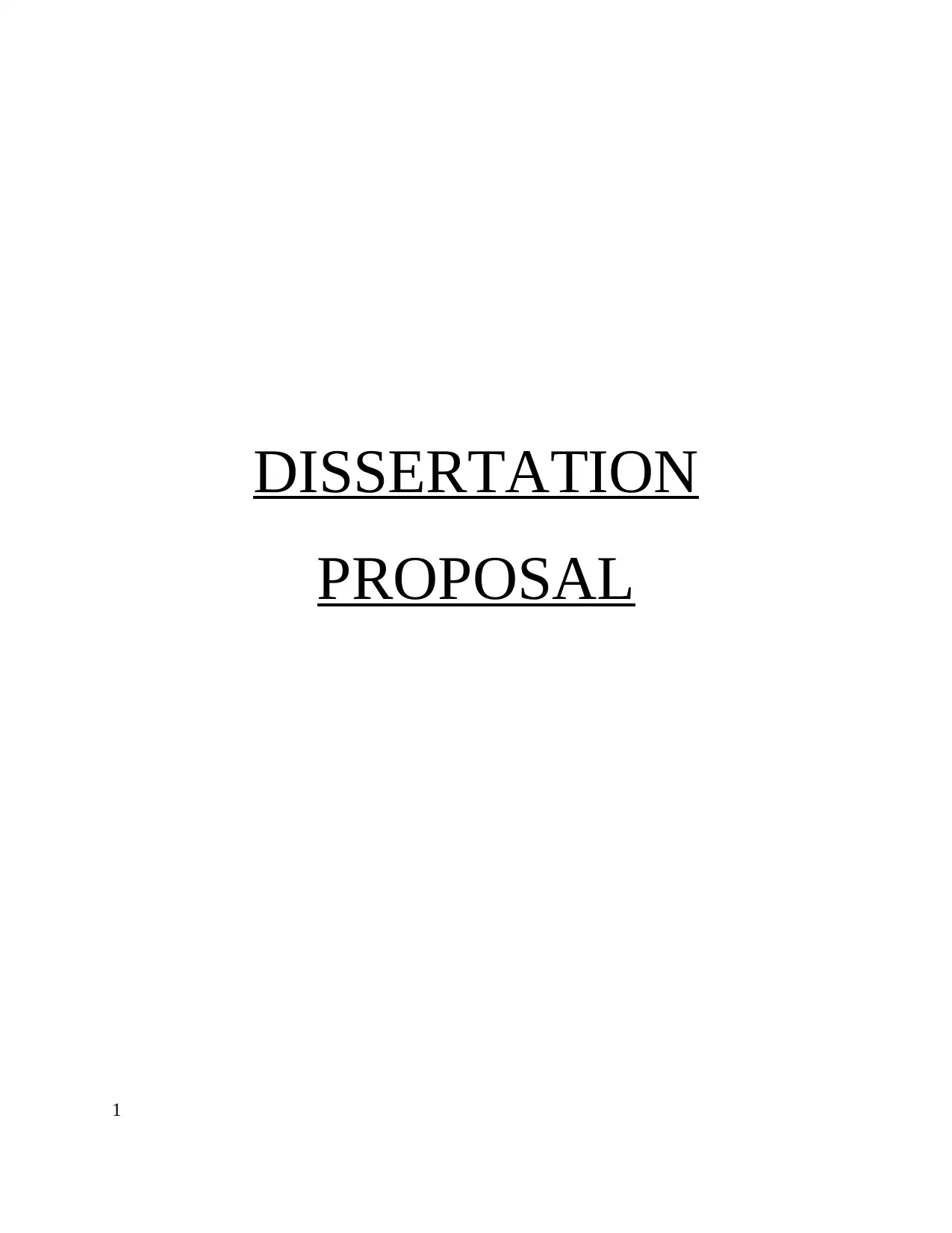
DISSERTATION
PROPOSAL
1
PROPOSAL
1
Paraphrase This Document
Need a fresh take? Get an instant paraphrase of this document with our AI Paraphraser
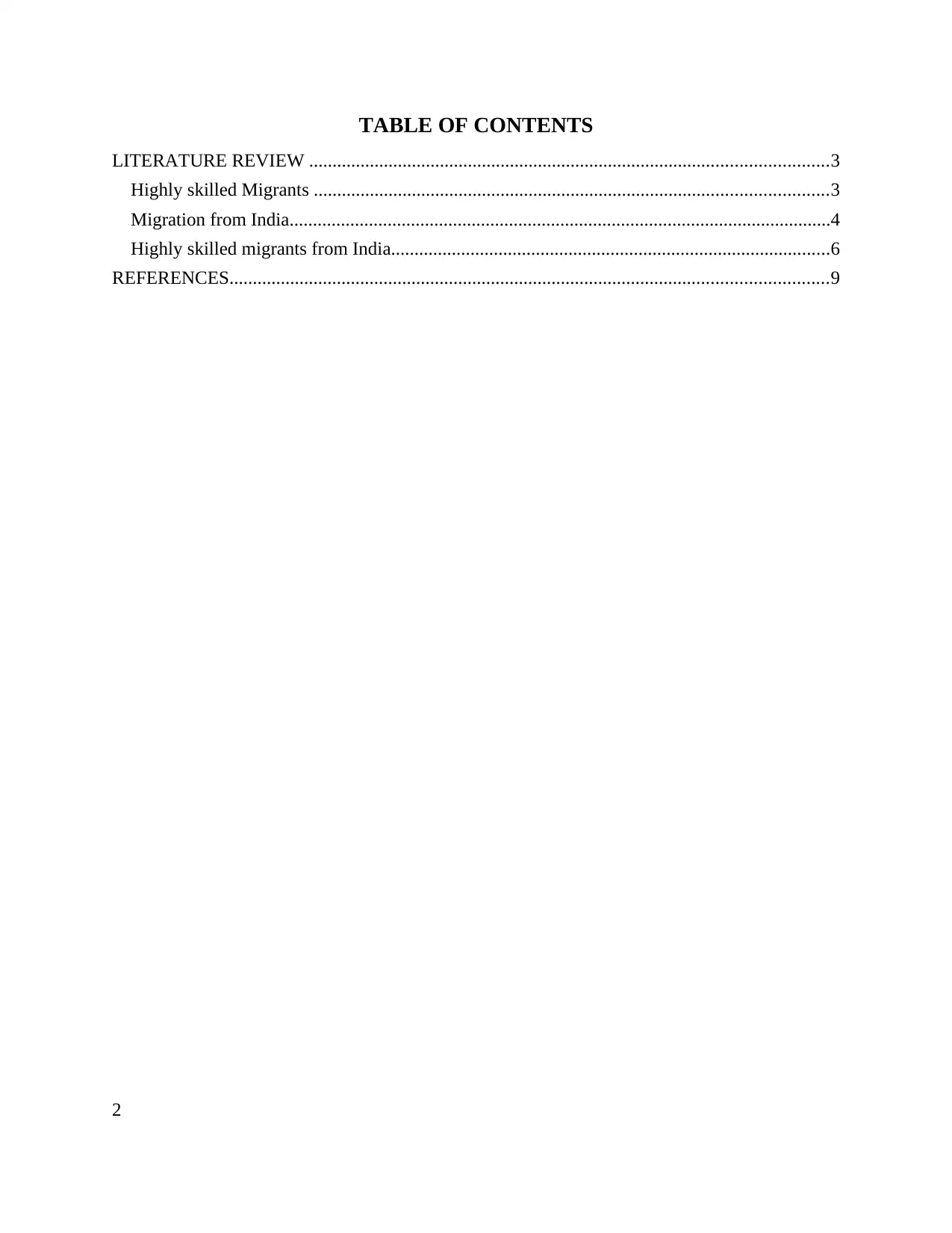
TABLE OF CONTENTS
LITERATURE REVIEW ...............................................................................................................3
Highly skilled Migrants ..............................................................................................................3
Migration from India....................................................................................................................4
Highly skilled migrants from India..............................................................................................6
REFERENCES................................................................................................................................9
2
LITERATURE REVIEW ...............................................................................................................3
Highly skilled Migrants ..............................................................................................................3
Migration from India....................................................................................................................4
Highly skilled migrants from India..............................................................................................6
REFERENCES................................................................................................................................9
2
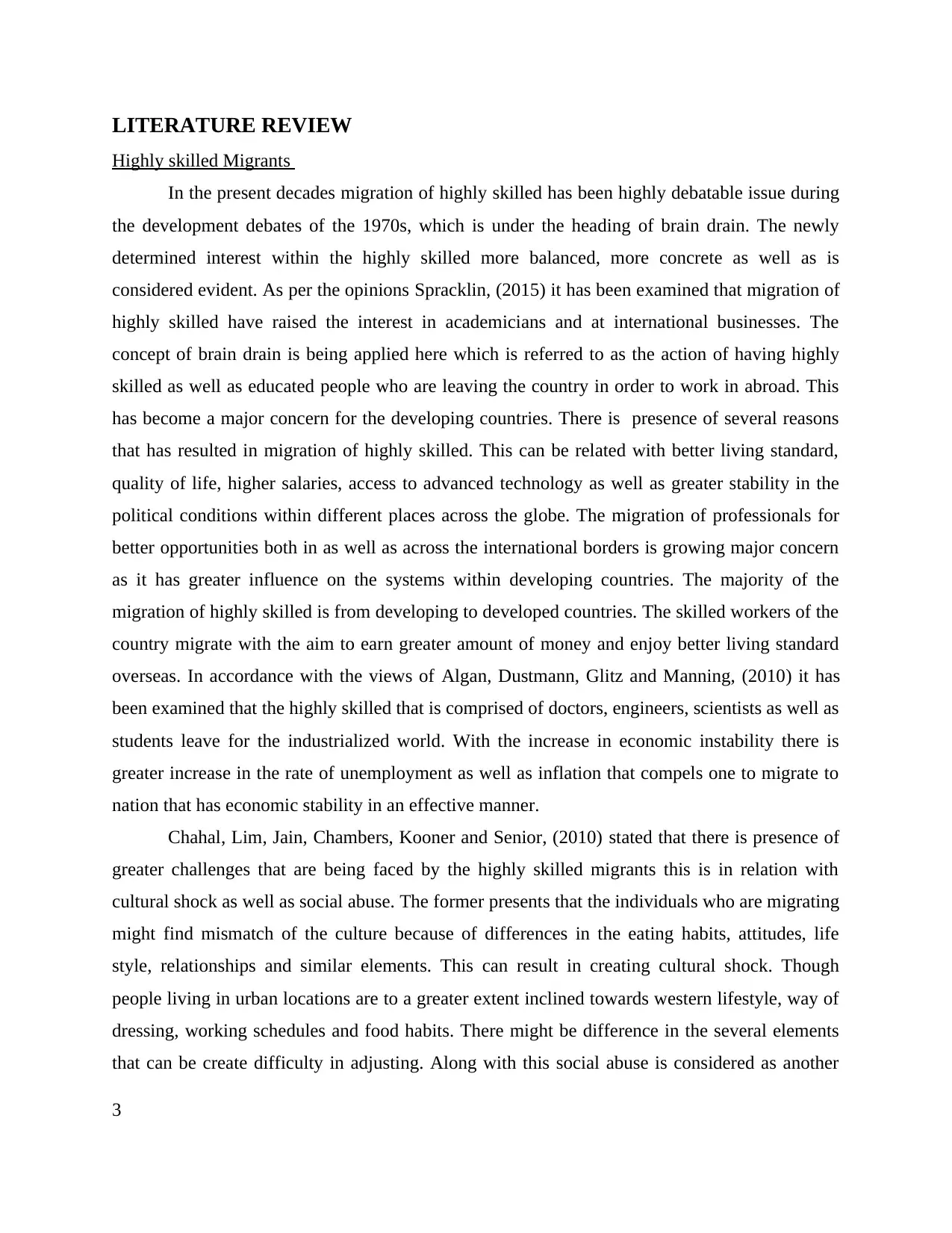
LITERATURE REVIEW
Highly skilled Migrants
In the present decades migration of highly skilled has been highly debatable issue during
the development debates of the 1970s, which is under the heading of brain drain. The newly
determined interest within the highly skilled more balanced, more concrete as well as is
considered evident. As per the opinions Spracklin, (2015) it has been examined that migration of
highly skilled have raised the interest in academicians and at international businesses. The
concept of brain drain is being applied here which is referred to as the action of having highly
skilled as well as educated people who are leaving the country in order to work in abroad. This
has become a major concern for the developing countries. There is presence of several reasons
that has resulted in migration of highly skilled. This can be related with better living standard,
quality of life, higher salaries, access to advanced technology as well as greater stability in the
political conditions within different places across the globe. The migration of professionals for
better opportunities both in as well as across the international borders is growing major concern
as it has greater influence on the systems within developing countries. The majority of the
migration of highly skilled is from developing to developed countries. The skilled workers of the
country migrate with the aim to earn greater amount of money and enjoy better living standard
overseas. In accordance with the views of Algan, Dustmann, Glitz and Manning, (2010) it has
been examined that the highly skilled that is comprised of doctors, engineers, scientists as well as
students leave for the industrialized world. With the increase in economic instability there is
greater increase in the rate of unemployment as well as inflation that compels one to migrate to
nation that has economic stability in an effective manner.
Chahal, Lim, Jain, Chambers, Kooner and Senior, (2010) stated that there is presence of
greater challenges that are being faced by the highly skilled migrants this is in relation with
cultural shock as well as social abuse. The former presents that the individuals who are migrating
might find mismatch of the culture because of differences in the eating habits, attitudes, life
style, relationships and similar elements. This can result in creating cultural shock. Though
people living in urban locations are to a greater extent inclined towards western lifestyle, way of
dressing, working schedules and food habits. There might be difference in the several elements
that can be create difficulty in adjusting. Along with this social abuse is considered as another
3
Highly skilled Migrants
In the present decades migration of highly skilled has been highly debatable issue during
the development debates of the 1970s, which is under the heading of brain drain. The newly
determined interest within the highly skilled more balanced, more concrete as well as is
considered evident. As per the opinions Spracklin, (2015) it has been examined that migration of
highly skilled have raised the interest in academicians and at international businesses. The
concept of brain drain is being applied here which is referred to as the action of having highly
skilled as well as educated people who are leaving the country in order to work in abroad. This
has become a major concern for the developing countries. There is presence of several reasons
that has resulted in migration of highly skilled. This can be related with better living standard,
quality of life, higher salaries, access to advanced technology as well as greater stability in the
political conditions within different places across the globe. The migration of professionals for
better opportunities both in as well as across the international borders is growing major concern
as it has greater influence on the systems within developing countries. The majority of the
migration of highly skilled is from developing to developed countries. The skilled workers of the
country migrate with the aim to earn greater amount of money and enjoy better living standard
overseas. In accordance with the views of Algan, Dustmann, Glitz and Manning, (2010) it has
been examined that the highly skilled that is comprised of doctors, engineers, scientists as well as
students leave for the industrialized world. With the increase in economic instability there is
greater increase in the rate of unemployment as well as inflation that compels one to migrate to
nation that has economic stability in an effective manner.
Chahal, Lim, Jain, Chambers, Kooner and Senior, (2010) stated that there is presence of
greater challenges that are being faced by the highly skilled migrants this is in relation with
cultural shock as well as social abuse. The former presents that the individuals who are migrating
might find mismatch of the culture because of differences in the eating habits, attitudes, life
style, relationships and similar elements. This can result in creating cultural shock. Though
people living in urban locations are to a greater extent inclined towards western lifestyle, way of
dressing, working schedules and food habits. There might be difference in the several elements
that can be create difficulty in adjusting. Along with this social abuse is considered as another
3
⊘ This is a preview!⊘
Do you want full access?
Subscribe today to unlock all pages.

Trusted by 1+ million students worldwide
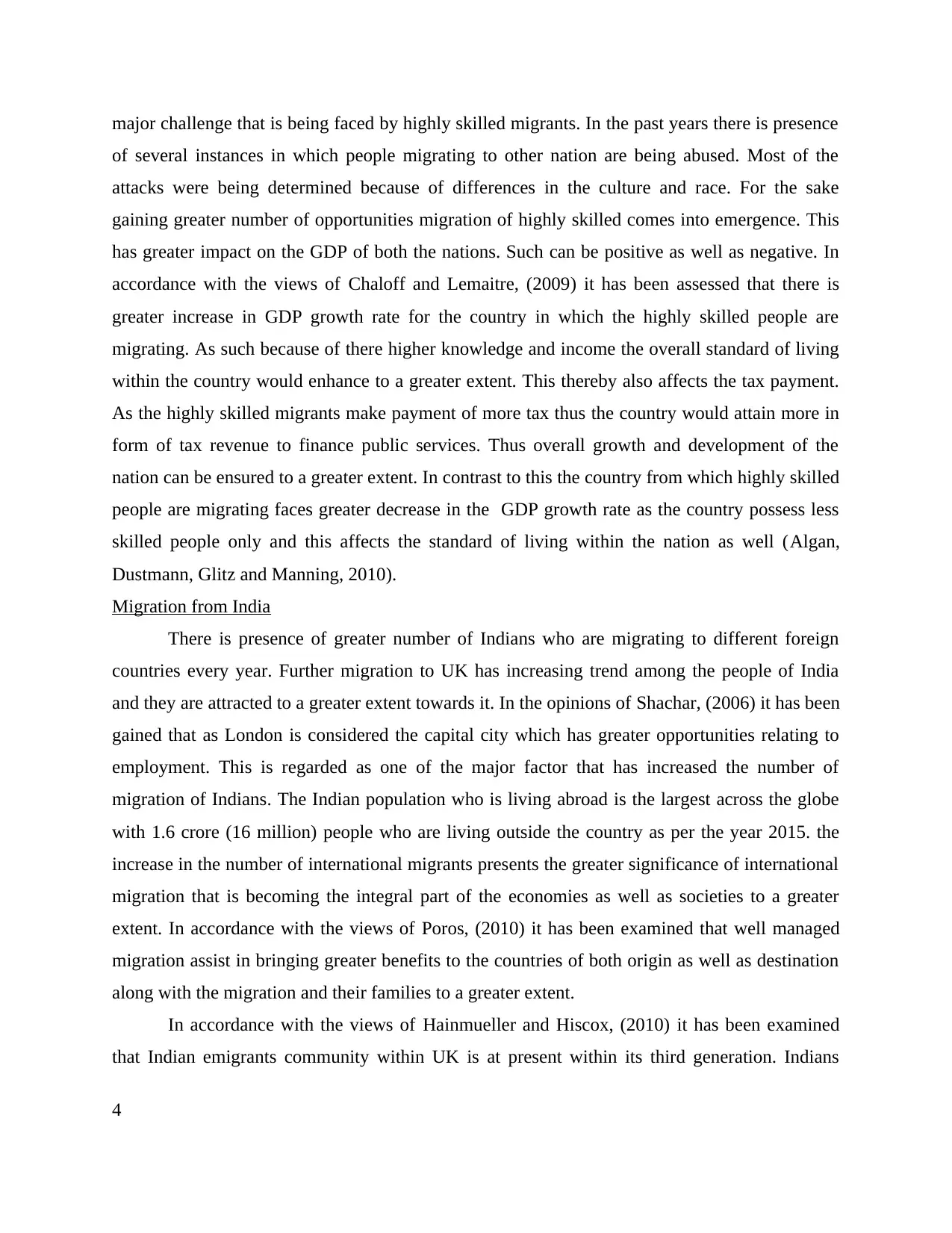
major challenge that is being faced by highly skilled migrants. In the past years there is presence
of several instances in which people migrating to other nation are being abused. Most of the
attacks were being determined because of differences in the culture and race. For the sake
gaining greater number of opportunities migration of highly skilled comes into emergence. This
has greater impact on the GDP of both the nations. Such can be positive as well as negative. In
accordance with the views of Chaloff and Lemaitre, (2009) it has been assessed that there is
greater increase in GDP growth rate for the country in which the highly skilled people are
migrating. As such because of there higher knowledge and income the overall standard of living
within the country would enhance to a greater extent. This thereby also affects the tax payment.
As the highly skilled migrants make payment of more tax thus the country would attain more in
form of tax revenue to finance public services. Thus overall growth and development of the
nation can be ensured to a greater extent. In contrast to this the country from which highly skilled
people are migrating faces greater decrease in the GDP growth rate as the country possess less
skilled people only and this affects the standard of living within the nation as well (Algan,
Dustmann, Glitz and Manning, 2010).
Migration from India
There is presence of greater number of Indians who are migrating to different foreign
countries every year. Further migration to UK has increasing trend among the people of India
and they are attracted to a greater extent towards it. In the opinions of Shachar, (2006) it has been
gained that as London is considered the capital city which has greater opportunities relating to
employment. This is regarded as one of the major factor that has increased the number of
migration of Indians. The Indian population who is living abroad is the largest across the globe
with 1.6 crore (16 million) people who are living outside the country as per the year 2015. the
increase in the number of international migrants presents the greater significance of international
migration that is becoming the integral part of the economies as well as societies to a greater
extent. In accordance with the views of Poros, (2010) it has been examined that well managed
migration assist in bringing greater benefits to the countries of both origin as well as destination
along with the migration and their families to a greater extent.
In accordance with the views of Hainmueller and Hiscox, (2010) it has been examined
that Indian emigrants community within UK is at present within its third generation. Indians
4
of several instances in which people migrating to other nation are being abused. Most of the
attacks were being determined because of differences in the culture and race. For the sake
gaining greater number of opportunities migration of highly skilled comes into emergence. This
has greater impact on the GDP of both the nations. Such can be positive as well as negative. In
accordance with the views of Chaloff and Lemaitre, (2009) it has been assessed that there is
greater increase in GDP growth rate for the country in which the highly skilled people are
migrating. As such because of there higher knowledge and income the overall standard of living
within the country would enhance to a greater extent. This thereby also affects the tax payment.
As the highly skilled migrants make payment of more tax thus the country would attain more in
form of tax revenue to finance public services. Thus overall growth and development of the
nation can be ensured to a greater extent. In contrast to this the country from which highly skilled
people are migrating faces greater decrease in the GDP growth rate as the country possess less
skilled people only and this affects the standard of living within the nation as well (Algan,
Dustmann, Glitz and Manning, 2010).
Migration from India
There is presence of greater number of Indians who are migrating to different foreign
countries every year. Further migration to UK has increasing trend among the people of India
and they are attracted to a greater extent towards it. In the opinions of Shachar, (2006) it has been
gained that as London is considered the capital city which has greater opportunities relating to
employment. This is regarded as one of the major factor that has increased the number of
migration of Indians. The Indian population who is living abroad is the largest across the globe
with 1.6 crore (16 million) people who are living outside the country as per the year 2015. the
increase in the number of international migrants presents the greater significance of international
migration that is becoming the integral part of the economies as well as societies to a greater
extent. In accordance with the views of Poros, (2010) it has been examined that well managed
migration assist in bringing greater benefits to the countries of both origin as well as destination
along with the migration and their families to a greater extent.
In accordance with the views of Hainmueller and Hiscox, (2010) it has been examined
that Indian emigrants community within UK is at present within its third generation. Indians
4
Paraphrase This Document
Need a fresh take? Get an instant paraphrase of this document with our AI Paraphraser
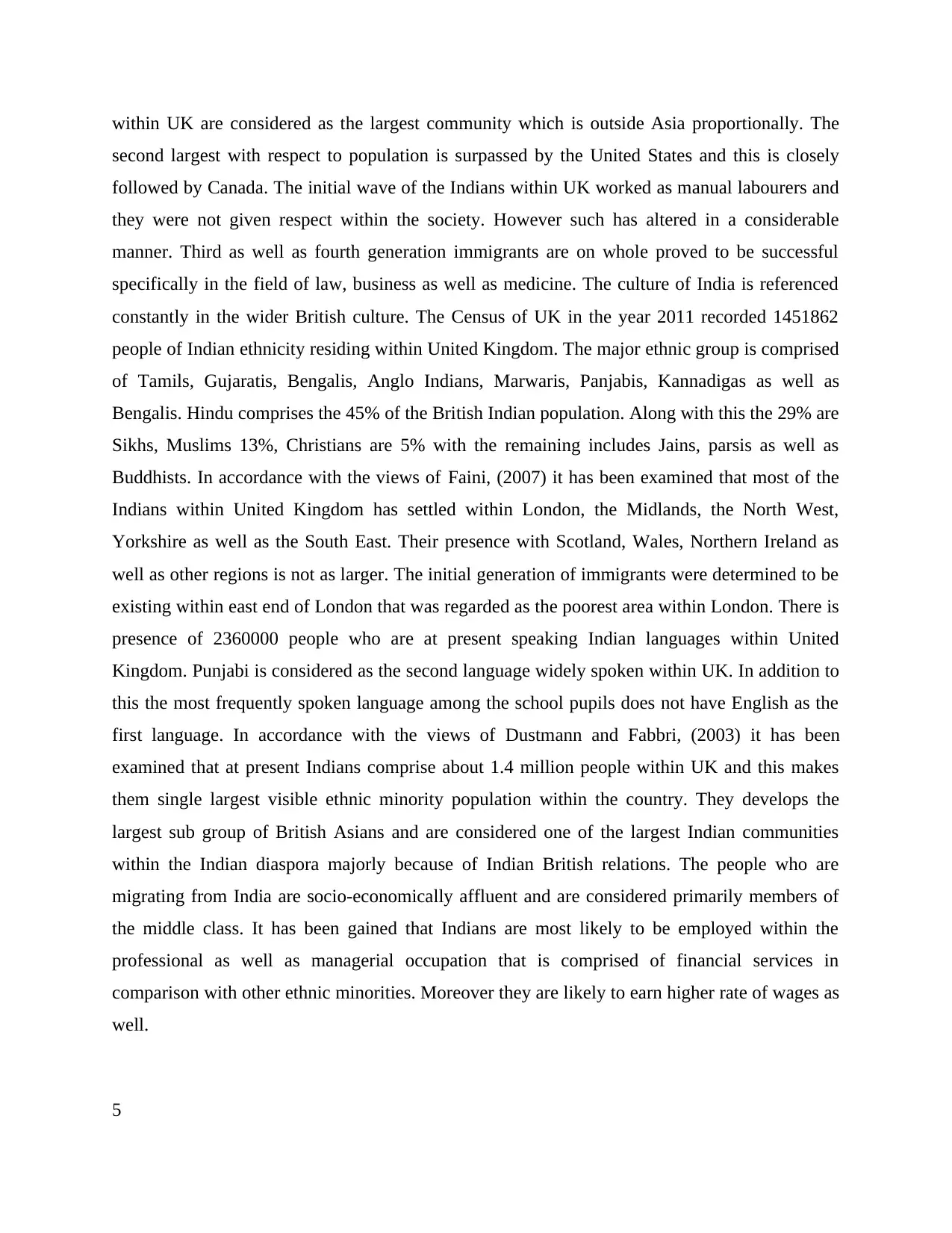
within UK are considered as the largest community which is outside Asia proportionally. The
second largest with respect to population is surpassed by the United States and this is closely
followed by Canada. The initial wave of the Indians within UK worked as manual labourers and
they were not given respect within the society. However such has altered in a considerable
manner. Third as well as fourth generation immigrants are on whole proved to be successful
specifically in the field of law, business as well as medicine. The culture of India is referenced
constantly in the wider British culture. The Census of UK in the year 2011 recorded 1451862
people of Indian ethnicity residing within United Kingdom. The major ethnic group is comprised
of Tamils, Gujaratis, Bengalis, Anglo Indians, Marwaris, Panjabis, Kannadigas as well as
Bengalis. Hindu comprises the 45% of the British Indian population. Along with this the 29% are
Sikhs, Muslims 13%, Christians are 5% with the remaining includes Jains, parsis as well as
Buddhists. In accordance with the views of Faini, (2007) it has been examined that most of the
Indians within United Kingdom has settled within London, the Midlands, the North West,
Yorkshire as well as the South East. Their presence with Scotland, Wales, Northern Ireland as
well as other regions is not as larger. The initial generation of immigrants were determined to be
existing within east end of London that was regarded as the poorest area within London. There is
presence of 2360000 people who are at present speaking Indian languages within United
Kingdom. Punjabi is considered as the second language widely spoken within UK. In addition to
this the most frequently spoken language among the school pupils does not have English as the
first language. In accordance with the views of Dustmann and Fabbri, (2003) it has been
examined that at present Indians comprise about 1.4 million people within UK and this makes
them single largest visible ethnic minority population within the country. They develops the
largest sub group of British Asians and are considered one of the largest Indian communities
within the Indian diaspora majorly because of Indian British relations. The people who are
migrating from India are socio-economically affluent and are considered primarily members of
the middle class. It has been gained that Indians are most likely to be employed within the
professional as well as managerial occupation that is comprised of financial services in
comparison with other ethnic minorities. Moreover they are likely to earn higher rate of wages as
well.
5
second largest with respect to population is surpassed by the United States and this is closely
followed by Canada. The initial wave of the Indians within UK worked as manual labourers and
they were not given respect within the society. However such has altered in a considerable
manner. Third as well as fourth generation immigrants are on whole proved to be successful
specifically in the field of law, business as well as medicine. The culture of India is referenced
constantly in the wider British culture. The Census of UK in the year 2011 recorded 1451862
people of Indian ethnicity residing within United Kingdom. The major ethnic group is comprised
of Tamils, Gujaratis, Bengalis, Anglo Indians, Marwaris, Panjabis, Kannadigas as well as
Bengalis. Hindu comprises the 45% of the British Indian population. Along with this the 29% are
Sikhs, Muslims 13%, Christians are 5% with the remaining includes Jains, parsis as well as
Buddhists. In accordance with the views of Faini, (2007) it has been examined that most of the
Indians within United Kingdom has settled within London, the Midlands, the North West,
Yorkshire as well as the South East. Their presence with Scotland, Wales, Northern Ireland as
well as other regions is not as larger. The initial generation of immigrants were determined to be
existing within east end of London that was regarded as the poorest area within London. There is
presence of 2360000 people who are at present speaking Indian languages within United
Kingdom. Punjabi is considered as the second language widely spoken within UK. In addition to
this the most frequently spoken language among the school pupils does not have English as the
first language. In accordance with the views of Dustmann and Fabbri, (2003) it has been
examined that at present Indians comprise about 1.4 million people within UK and this makes
them single largest visible ethnic minority population within the country. They develops the
largest sub group of British Asians and are considered one of the largest Indian communities
within the Indian diaspora majorly because of Indian British relations. The people who are
migrating from India are socio-economically affluent and are considered primarily members of
the middle class. It has been gained that Indians are most likely to be employed within the
professional as well as managerial occupation that is comprised of financial services in
comparison with other ethnic minorities. Moreover they are likely to earn higher rate of wages as
well.
5
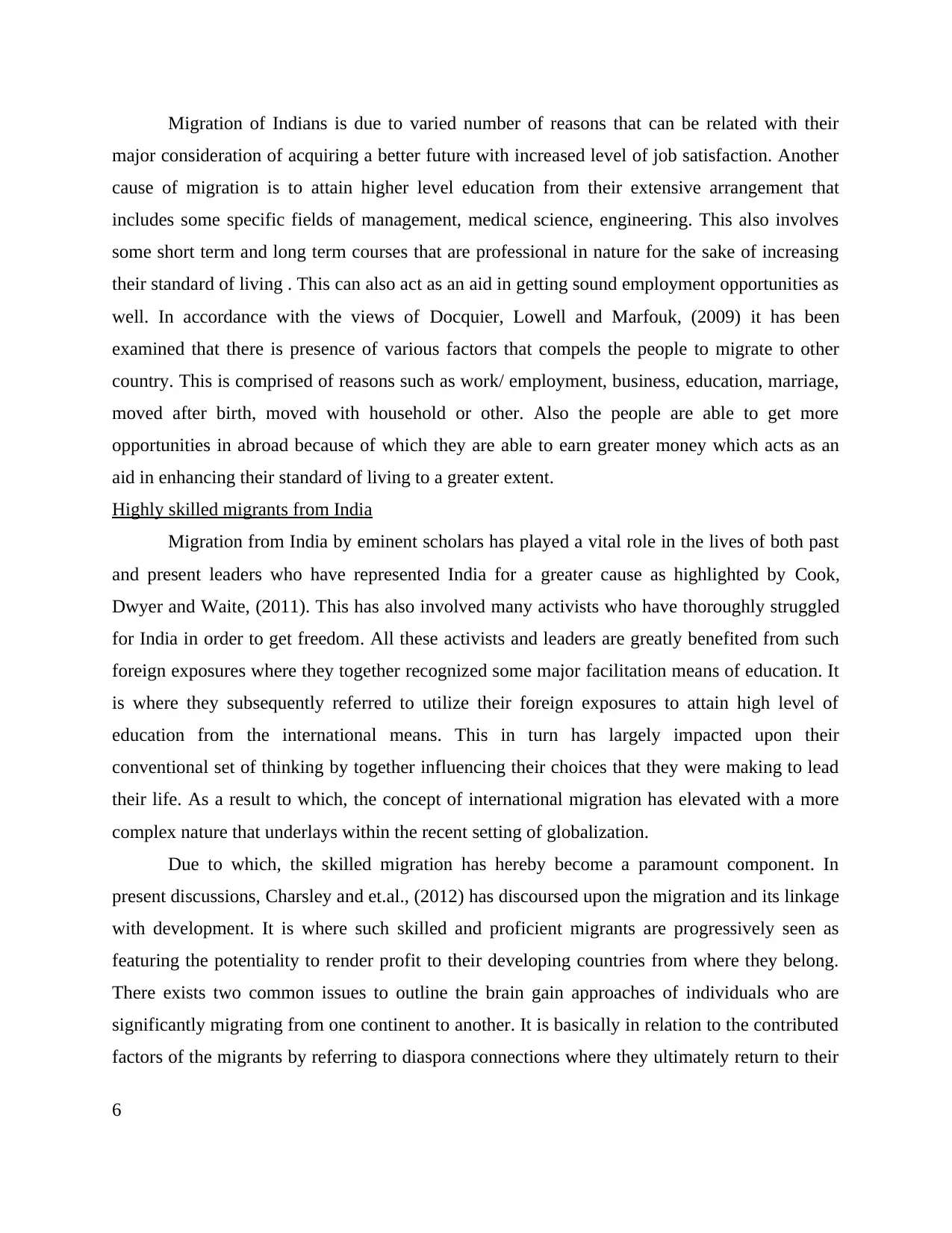
Migration of Indians is due to varied number of reasons that can be related with their
major consideration of acquiring a better future with increased level of job satisfaction. Another
cause of migration is to attain higher level education from their extensive arrangement that
includes some specific fields of management, medical science, engineering. This also involves
some short term and long term courses that are professional in nature for the sake of increasing
their standard of living . This can also act as an aid in getting sound employment opportunities as
well. In accordance with the views of Docquier, Lowell and Marfouk, (2009) it has been
examined that there is presence of various factors that compels the people to migrate to other
country. This is comprised of reasons such as work/ employment, business, education, marriage,
moved after birth, moved with household or other. Also the people are able to get more
opportunities in abroad because of which they are able to earn greater money which acts as an
aid in enhancing their standard of living to a greater extent.
Highly skilled migrants from India
Migration from India by eminent scholars has played a vital role in the lives of both past
and present leaders who have represented India for a greater cause as highlighted by Cook,
Dwyer and Waite, (2011). This has also involved many activists who have thoroughly struggled
for India in order to get freedom. All these activists and leaders are greatly benefited from such
foreign exposures where they together recognized some major facilitation means of education. It
is where they subsequently referred to utilize their foreign exposures to attain high level of
education from the international means. This in turn has largely impacted upon their
conventional set of thinking by together influencing their choices that they were making to lead
their life. As a result to which, the concept of international migration has elevated with a more
complex nature that underlays within the recent setting of globalization.
Due to which, the skilled migration has hereby become a paramount component. In
present discussions, Charsley and et.al., (2012) has discoursed upon the migration and its linkage
with development. It is where such skilled and proficient migrants are progressively seen as
featuring the potentiality to render profit to their developing countries from where they belong.
There exists two common issues to outline the brain gain approaches of individuals who are
significantly migrating from one continent to another. It is basically in relation to the contributed
factors of the migrants by referring to diaspora connections where they ultimately return to their
6
major consideration of acquiring a better future with increased level of job satisfaction. Another
cause of migration is to attain higher level education from their extensive arrangement that
includes some specific fields of management, medical science, engineering. This also involves
some short term and long term courses that are professional in nature for the sake of increasing
their standard of living . This can also act as an aid in getting sound employment opportunities as
well. In accordance with the views of Docquier, Lowell and Marfouk, (2009) it has been
examined that there is presence of various factors that compels the people to migrate to other
country. This is comprised of reasons such as work/ employment, business, education, marriage,
moved after birth, moved with household or other. Also the people are able to get more
opportunities in abroad because of which they are able to earn greater money which acts as an
aid in enhancing their standard of living to a greater extent.
Highly skilled migrants from India
Migration from India by eminent scholars has played a vital role in the lives of both past
and present leaders who have represented India for a greater cause as highlighted by Cook,
Dwyer and Waite, (2011). This has also involved many activists who have thoroughly struggled
for India in order to get freedom. All these activists and leaders are greatly benefited from such
foreign exposures where they together recognized some major facilitation means of education. It
is where they subsequently referred to utilize their foreign exposures to attain high level of
education from the international means. This in turn has largely impacted upon their
conventional set of thinking by together influencing their choices that they were making to lead
their life. As a result to which, the concept of international migration has elevated with a more
complex nature that underlays within the recent setting of globalization.
Due to which, the skilled migration has hereby become a paramount component. In
present discussions, Charsley and et.al., (2012) has discoursed upon the migration and its linkage
with development. It is where such skilled and proficient migrants are progressively seen as
featuring the potentiality to render profit to their developing countries from where they belong.
There exists two common issues to outline the brain gain approaches of individuals who are
significantly migrating from one continent to another. It is basically in relation to the contributed
factors of the migrants by referring to diaspora connections where they ultimately return to their
6
⊘ This is a preview!⊘
Do you want full access?
Subscribe today to unlock all pages.

Trusted by 1+ million students worldwide
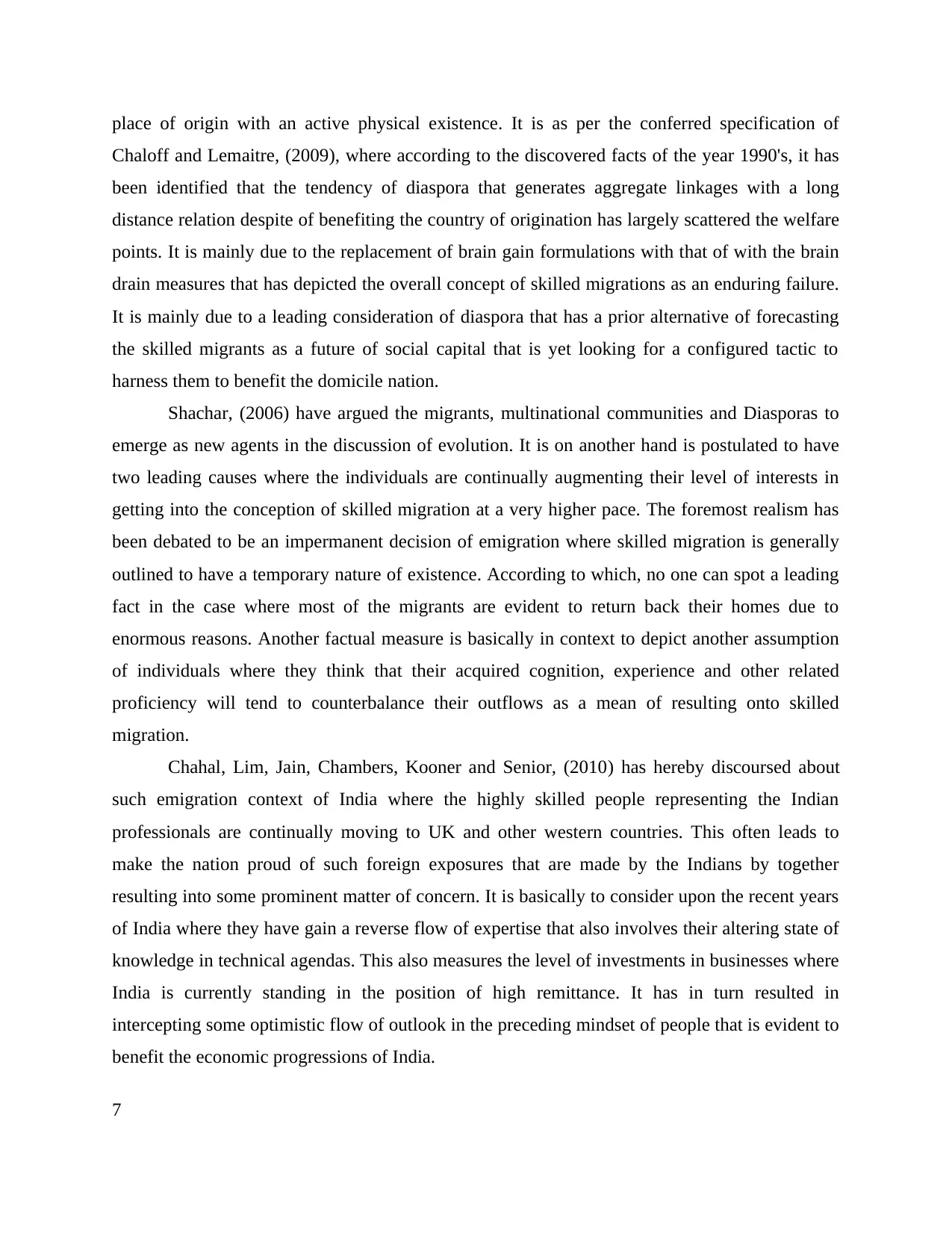
place of origin with an active physical existence. It is as per the conferred specification of
Chaloff and Lemaitre, (2009), where according to the discovered facts of the year 1990's, it has
been identified that the tendency of diaspora that generates aggregate linkages with a long
distance relation despite of benefiting the country of origination has largely scattered the welfare
points. It is mainly due to the replacement of brain gain formulations with that of with the brain
drain measures that has depicted the overall concept of skilled migrations as an enduring failure.
It is mainly due to a leading consideration of diaspora that has a prior alternative of forecasting
the skilled migrants as a future of social capital that is yet looking for a configured tactic to
harness them to benefit the domicile nation.
Shachar, (2006) have argued the migrants, multinational communities and Diasporas to
emerge as new agents in the discussion of evolution. It is on another hand is postulated to have
two leading causes where the individuals are continually augmenting their level of interests in
getting into the conception of skilled migration at a very higher pace. The foremost realism has
been debated to be an impermanent decision of emigration where skilled migration is generally
outlined to have a temporary nature of existence. According to which, no one can spot a leading
fact in the case where most of the migrants are evident to return back their homes due to
enormous reasons. Another factual measure is basically in context to depict another assumption
of individuals where they think that their acquired cognition, experience and other related
proficiency will tend to counterbalance their outflows as a mean of resulting onto skilled
migration.
Chahal, Lim, Jain, Chambers, Kooner and Senior, (2010) has hereby discoursed about
such emigration context of India where the highly skilled people representing the Indian
professionals are continually moving to UK and other western countries. This often leads to
make the nation proud of such foreign exposures that are made by the Indians by together
resulting into some prominent matter of concern. It is basically to consider upon the recent years
of India where they have gain a reverse flow of expertise that also involves their altering state of
knowledge in technical agendas. This also measures the level of investments in businesses where
India is currently standing in the position of high remittance. It has in turn resulted in
intercepting some optimistic flow of outlook in the preceding mindset of people that is evident to
benefit the economic progressions of India.
7
Chaloff and Lemaitre, (2009), where according to the discovered facts of the year 1990's, it has
been identified that the tendency of diaspora that generates aggregate linkages with a long
distance relation despite of benefiting the country of origination has largely scattered the welfare
points. It is mainly due to the replacement of brain gain formulations with that of with the brain
drain measures that has depicted the overall concept of skilled migrations as an enduring failure.
It is mainly due to a leading consideration of diaspora that has a prior alternative of forecasting
the skilled migrants as a future of social capital that is yet looking for a configured tactic to
harness them to benefit the domicile nation.
Shachar, (2006) have argued the migrants, multinational communities and Diasporas to
emerge as new agents in the discussion of evolution. It is on another hand is postulated to have
two leading causes where the individuals are continually augmenting their level of interests in
getting into the conception of skilled migration at a very higher pace. The foremost realism has
been debated to be an impermanent decision of emigration where skilled migration is generally
outlined to have a temporary nature of existence. According to which, no one can spot a leading
fact in the case where most of the migrants are evident to return back their homes due to
enormous reasons. Another factual measure is basically in context to depict another assumption
of individuals where they think that their acquired cognition, experience and other related
proficiency will tend to counterbalance their outflows as a mean of resulting onto skilled
migration.
Chahal, Lim, Jain, Chambers, Kooner and Senior, (2010) has hereby discoursed about
such emigration context of India where the highly skilled people representing the Indian
professionals are continually moving to UK and other western countries. This often leads to
make the nation proud of such foreign exposures that are made by the Indians by together
resulting into some prominent matter of concern. It is basically to consider upon the recent years
of India where they have gain a reverse flow of expertise that also involves their altering state of
knowledge in technical agendas. This also measures the level of investments in businesses where
India is currently standing in the position of high remittance. It has in turn resulted in
intercepting some optimistic flow of outlook in the preceding mindset of people that is evident to
benefit the economic progressions of India.
7
Paraphrase This Document
Need a fresh take? Get an instant paraphrase of this document with our AI Paraphraser
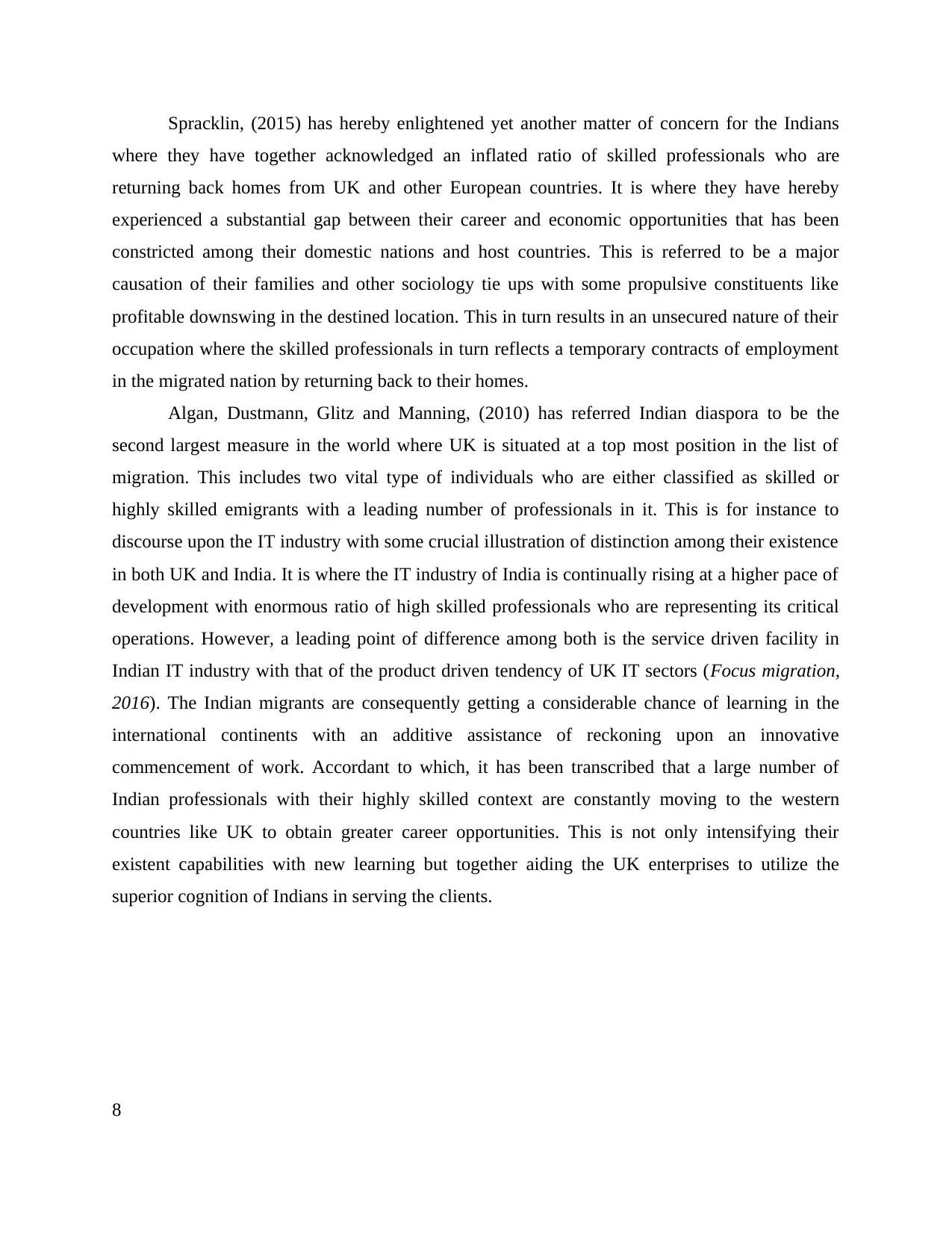
Spracklin, (2015) has hereby enlightened yet another matter of concern for the Indians
where they have together acknowledged an inflated ratio of skilled professionals who are
returning back homes from UK and other European countries. It is where they have hereby
experienced a substantial gap between their career and economic opportunities that has been
constricted among their domestic nations and host countries. This is referred to be a major
causation of their families and other sociology tie ups with some propulsive constituents like
profitable downswing in the destined location. This in turn results in an unsecured nature of their
occupation where the skilled professionals in turn reflects a temporary contracts of employment
in the migrated nation by returning back to their homes.
Algan, Dustmann, Glitz and Manning, (2010) has referred Indian diaspora to be the
second largest measure in the world where UK is situated at a top most position in the list of
migration. This includes two vital type of individuals who are either classified as skilled or
highly skilled emigrants with a leading number of professionals in it. This is for instance to
discourse upon the IT industry with some crucial illustration of distinction among their existence
in both UK and India. It is where the IT industry of India is continually rising at a higher pace of
development with enormous ratio of high skilled professionals who are representing its critical
operations. However, a leading point of difference among both is the service driven facility in
Indian IT industry with that of the product driven tendency of UK IT sectors (Focus migration,
2016). The Indian migrants are consequently getting a considerable chance of learning in the
international continents with an additive assistance of reckoning upon an innovative
commencement of work. Accordant to which, it has been transcribed that a large number of
Indian professionals with their highly skilled context are constantly moving to the western
countries like UK to obtain greater career opportunities. This is not only intensifying their
existent capabilities with new learning but together aiding the UK enterprises to utilize the
superior cognition of Indians in serving the clients.
8
where they have together acknowledged an inflated ratio of skilled professionals who are
returning back homes from UK and other European countries. It is where they have hereby
experienced a substantial gap between their career and economic opportunities that has been
constricted among their domestic nations and host countries. This is referred to be a major
causation of their families and other sociology tie ups with some propulsive constituents like
profitable downswing in the destined location. This in turn results in an unsecured nature of their
occupation where the skilled professionals in turn reflects a temporary contracts of employment
in the migrated nation by returning back to their homes.
Algan, Dustmann, Glitz and Manning, (2010) has referred Indian diaspora to be the
second largest measure in the world where UK is situated at a top most position in the list of
migration. This includes two vital type of individuals who are either classified as skilled or
highly skilled emigrants with a leading number of professionals in it. This is for instance to
discourse upon the IT industry with some crucial illustration of distinction among their existence
in both UK and India. It is where the IT industry of India is continually rising at a higher pace of
development with enormous ratio of high skilled professionals who are representing its critical
operations. However, a leading point of difference among both is the service driven facility in
Indian IT industry with that of the product driven tendency of UK IT sectors (Focus migration,
2016). The Indian migrants are consequently getting a considerable chance of learning in the
international continents with an additive assistance of reckoning upon an innovative
commencement of work. Accordant to which, it has been transcribed that a large number of
Indian professionals with their highly skilled context are constantly moving to the western
countries like UK to obtain greater career opportunities. This is not only intensifying their
existent capabilities with new learning but together aiding the UK enterprises to utilize the
superior cognition of Indians in serving the clients.
8
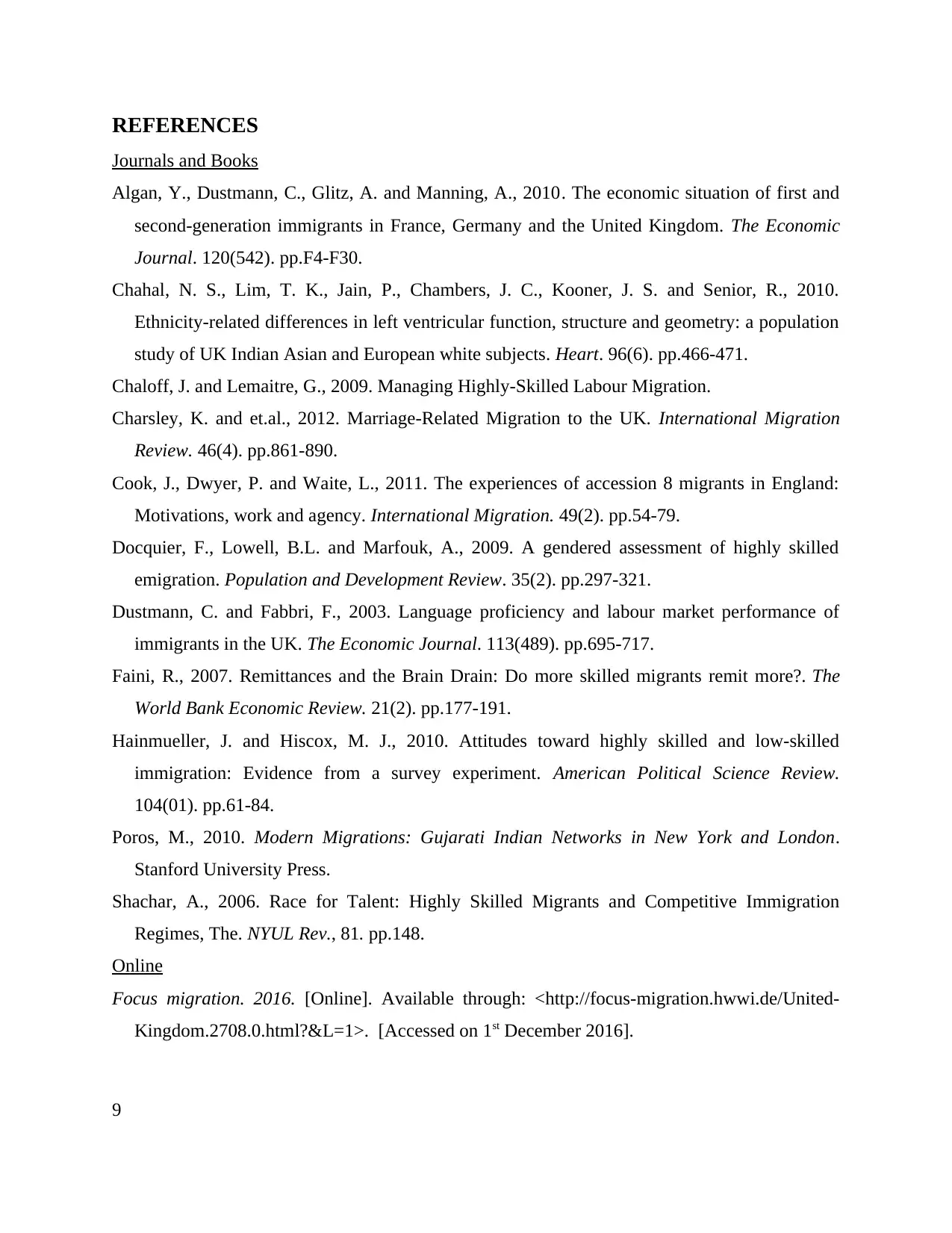
REFERENCES
Journals and Books
Algan, Y., Dustmann, C., Glitz, A. and Manning, A., 2010. The economic situation of first and
second‐generation immigrants in France, Germany and the United Kingdom. The Economic
Journal. 120(542). pp.F4-F30.
Chahal, N. S., Lim, T. K., Jain, P., Chambers, J. C., Kooner, J. S. and Senior, R., 2010.
Ethnicity-related differences in left ventricular function, structure and geometry: a population
study of UK Indian Asian and European white subjects. Heart. 96(6). pp.466-471.
Chaloff, J. and Lemaitre, G., 2009. Managing Highly-Skilled Labour Migration.
Charsley, K. and et.al., 2012. Marriage‐Related Migration to the UK. International Migration
Review. 46(4). pp.861-890.
Cook, J., Dwyer, P. and Waite, L., 2011. The experiences of accession 8 migrants in England:
Motivations, work and agency. International Migration. 49(2). pp.54-79.
Docquier, F., Lowell, B.L. and Marfouk, A., 2009. A gendered assessment of highly skilled
emigration. Population and Development Review. 35(2). pp.297-321.
Dustmann, C. and Fabbri, F., 2003. Language proficiency and labour market performance of
immigrants in the UK. The Economic Journal. 113(489). pp.695-717.
Faini, R., 2007. Remittances and the Brain Drain: Do more skilled migrants remit more?. The
World Bank Economic Review. 21(2). pp.177-191.
Hainmueller, J. and Hiscox, M. J., 2010. Attitudes toward highly skilled and low-skilled
immigration: Evidence from a survey experiment. American Political Science Review.
104(01). pp.61-84.
Poros, M., 2010. Modern Migrations: Gujarati Indian Networks in New York and London.
Stanford University Press.
Shachar, A., 2006. Race for Talent: Highly Skilled Migrants and Competitive Immigration
Regimes, The. NYUL Rev., 81. pp.148.
Online
Focus migration. 2016. [Online]. Available through: <http://focus-migration.hwwi.de/United-
Kingdom.2708.0.html?&L=1>. [Accessed on 1st December 2016].
9
Journals and Books
Algan, Y., Dustmann, C., Glitz, A. and Manning, A., 2010. The economic situation of first and
second‐generation immigrants in France, Germany and the United Kingdom. The Economic
Journal. 120(542). pp.F4-F30.
Chahal, N. S., Lim, T. K., Jain, P., Chambers, J. C., Kooner, J. S. and Senior, R., 2010.
Ethnicity-related differences in left ventricular function, structure and geometry: a population
study of UK Indian Asian and European white subjects. Heart. 96(6). pp.466-471.
Chaloff, J. and Lemaitre, G., 2009. Managing Highly-Skilled Labour Migration.
Charsley, K. and et.al., 2012. Marriage‐Related Migration to the UK. International Migration
Review. 46(4). pp.861-890.
Cook, J., Dwyer, P. and Waite, L., 2011. The experiences of accession 8 migrants in England:
Motivations, work and agency. International Migration. 49(2). pp.54-79.
Docquier, F., Lowell, B.L. and Marfouk, A., 2009. A gendered assessment of highly skilled
emigration. Population and Development Review. 35(2). pp.297-321.
Dustmann, C. and Fabbri, F., 2003. Language proficiency and labour market performance of
immigrants in the UK. The Economic Journal. 113(489). pp.695-717.
Faini, R., 2007. Remittances and the Brain Drain: Do more skilled migrants remit more?. The
World Bank Economic Review. 21(2). pp.177-191.
Hainmueller, J. and Hiscox, M. J., 2010. Attitudes toward highly skilled and low-skilled
immigration: Evidence from a survey experiment. American Political Science Review.
104(01). pp.61-84.
Poros, M., 2010. Modern Migrations: Gujarati Indian Networks in New York and London.
Stanford University Press.
Shachar, A., 2006. Race for Talent: Highly Skilled Migrants and Competitive Immigration
Regimes, The. NYUL Rev., 81. pp.148.
Online
Focus migration. 2016. [Online]. Available through: <http://focus-migration.hwwi.de/United-
Kingdom.2708.0.html?&L=1>. [Accessed on 1st December 2016].
9
⊘ This is a preview!⊘
Do you want full access?
Subscribe today to unlock all pages.

Trusted by 1+ million students worldwide

Spracklin, P. 2015. The Top 10 Problems Faced by Immigrants. [Online]. Available through:
<http://www.immigroup.com/news/top-10-problems-immigrants>. [Accessed on 1st
December 2016].
10
<http://www.immigroup.com/news/top-10-problems-immigrants>. [Accessed on 1st
December 2016].
10
1 out of 10
Related Documents
Your All-in-One AI-Powered Toolkit for Academic Success.
+13062052269
info@desklib.com
Available 24*7 on WhatsApp / Email
![[object Object]](/_next/static/media/star-bottom.7253800d.svg)
Unlock your academic potential
Copyright © 2020–2025 A2Z Services. All Rights Reserved. Developed and managed by ZUCOL.





